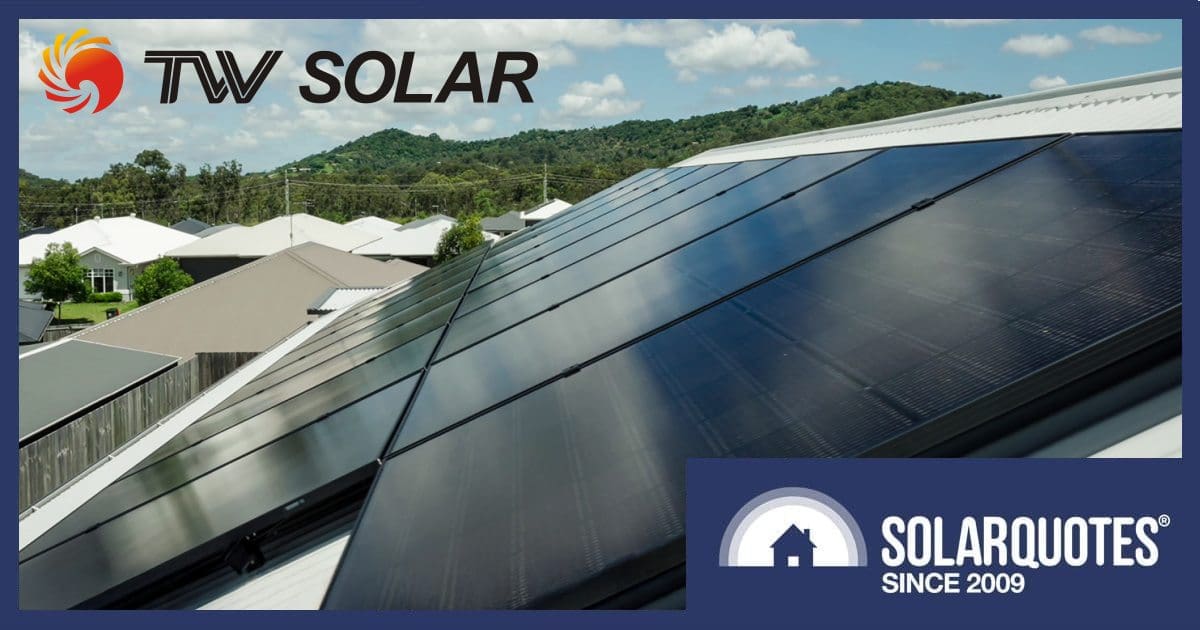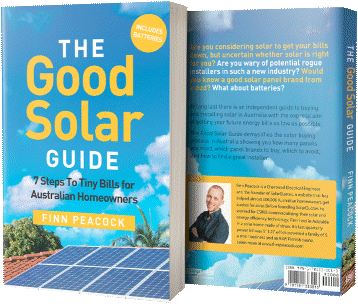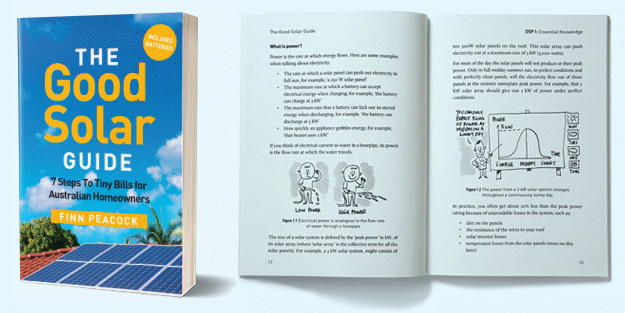
Australians have a new choice in high-power rooftop solar panels; one that appears to be built particularly tough for our often-harsh conditions — TW Solar’s 470-Watt TWMNH-48HE470.
How Tough Is The TWMNH-48HE470?
A full-black monofacial dual-glass solar panel with a footprint of 2m2, the TW Solar TWMNH-48HE470 is suitable for installation in coastal locations. There’s nothing particularly special in that, but additionally the panel is cyclone-rated and hail impact tested to 44.9 mm hailstones at 110 km/h1. That’s slightly larger than the diameter of a golf ball, which is 42.67 mm. The standard IEC hail test involves 25 mm hailstones at 82.8 km/h.
More TWMNH-48HE470 Specifications
- Maximum Power: 470W
- Cell Type: TNC (N Type monocrystalline cells)
- Module efficiency: 23.5%
- Temperature Coefficient (Pmax): -0.28%/°C
- Maximum System Voltage: 1500V DC
- Dimensions: 1762mm x 1134mm x 30mm
- Weight: 22.8kg
- Glass (front and back): 2mm
- Operating Temperature: -40°C to + 70°C
- 25- year product warranty (rooftop installs).
- 30- year performance warranty for roof- mounted installations (1st year degradation <1%, <0.4% annually thereafter for a capacity not less than 87.4% at the end of year 30).
A full datasheet is available here.
TW Solar’s contender is heavier than some we’ve seen in this wattage range due to the 2mm glass front and back. There are manufacturers opting for 1.6mm instead; sacrificing some strength as a result2.
The TWMNH-48HE470 is being exclusively launched in Australia this month by national wholesale distributor of solar gear Supply Partners, which has warehouses in Brisbane, Townsville, Sydney, Melbourne and Perth.
“TW Solar is one of the world’s only fully integrated solar manufacturers, giving them unparalleled control over quality, supply, and innovation,” said Supply Partners’ John Degotardi. “Our partners are looking forward to offering one of the best specified and most value-focused solar panels in the Australian market today.”
As for pricing and like other TW Solar panels, I’m assuming the TWMNH-48HE470 should come in towards the budget-friendly end of the spectrum.
Supply Partners says it will be showcasing the panel at All Energy Australia in Melbourne late this month. The event is promoted as the largest gathering of renewable energy professionals in the Southern Hemisphere.
Who Is TW Solar (aka Tongwei Solar)?
China’s TW Solar is one of the world’s largest PV manufacturers and commenced making solar cells for other companies in 2009. The firm then moved into producing their own panels, evolving into a vertically integrated company controlling the entire process; from refining polysilicon to assembling the final product.
Tongwei opened an Australian office this year in North Sydney, but their panels were being installed here for a few years prior.
TW Solar panel reviews here on SolarQuotes from Australian customers have been generally positive to date, with the company averaging a 4.9 star rating. However, we only have a few dozen customer reviews so far, compared to some of the longer established brands in Australia that have hundreds — and some with thousands — of reviews. The company is currently listed as a SolarQuotes approved solar panel brand.
Among other manufacturers to release high-power solar panels suitable for Australian rooftops this year are Risen Energy (475 W), Aiko (480 W) and Winaico (475 W). Risen and Aiko tend to cater towards the budget end of the market, with Winaico being more middle-of-the-road on pricing.
Learn everything you need to know about choosing the right solar panels for your home; or check out some other high-efficiency modules here. We still need to update the table on that page with some of the products more recently made available in Australia; including this one from Tongwei.
Footnotes
- The hailstone resistance is pretty impressive, but there’s hail and then there’s hail; such as what was experienced in parts of South-East Queensland a few years back that you wouldn’t expect any solar panel with a glass face to stand up to. ↩
- But spare a thought for the installers having to wrangle with increasingly large and heavy solar panels. ↩

 RSS - Posts
RSS - Posts



It is unfortunate that the photovoltaic panel manufacturers do not truly make panels for Australian household rooftops.
If they did, the panels would be no bigger than about one metre square, to increase efficiency, to better make use of the restrictions of hip roof faces.
How many panel manufacturers have performed or commissioned surveys of the angular aspects of hip roof faces, and, the proportion of Australian households that have hip roofs?
It is of the nature of the part of mathematics named operations research, which is about maximising economic efficiency., for which, the panel manufacturers appear to have no regard.
So, the efficiency of photovoltaic panels should not be expressed as the amount of electricity that can be generated relative to the surface area of a panel, but, should be expressed as the amount of energy that can be generated relative to the area of the smallest household hip roof face.
I just can’t believe how complicated many Aussie roofs are- and I’ll bet that when people buy (or build) such houses they don’t think how bad this is for installing a good sized solar array.
If I were buying a house, that would be a real red flag for me (as would a dark coloured roof which just magnifies the heat issues in Summer.
Thank’s for that Finn,
At least 17 redundant hips, valleys & ridges.
You gave me eye cancer again 😛
Ooh I got a better one, I pass the front house on the way to work but the back house is something else…:
https://maps.app.goo.gl/bw4KH2tu82k8tJQcA
Jebus Scott,
It’s not even the only one on that block… O.o
https://maps.app.goo.gl/jPmr2NWRtJ9oNGM47
I mostly lurk in the SQ Blog comments but I HAD to share this house in my area…
https://maps.app.goo.gl/rDj5SjSYW8raKJgW7
Australian Roof designs are a byproduct of bypassing the architectural process which results in large excessively angled houses as the customers and building companies have no respect for the science of Architecture and good design. I’m currently building and a rectangular with a scillion roof was a no brainer.
I am yet to find out why most houses built in Australia have a glut of right angles. No idea why, seems like it would only make it more expensive to boot rather than a refined, purposeful approach to designing a house.
Hi Luke,
We’d love to hear about what you’re building. I share your disdain for Australian builders.
I’ve read about metallic mesh systems sometimes used to protect panels from hail in high risk areas, with regular and large hailstones. Like a layer of metallic mesh installed to sit above the panels. Is there any SQ wisdom about that?
The size is right but when are they going to be 500kw+?
500W in the same footprint? Next year
Regarding solar panels and storms in Australian conditions – I’m concerned about bushfire standards and avoiding birds nests.. I don’t believe there are any bushfire recommendations for anything to do with solar rooftop installations. Something that prevents small twigs and leaves from being blown underneath the panels, waiting there to ignite from an ember attack would be useful –